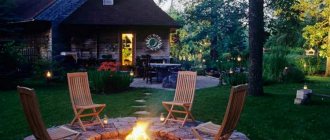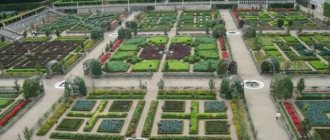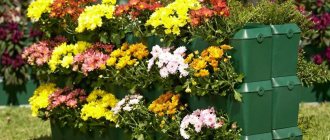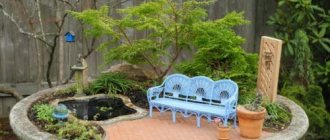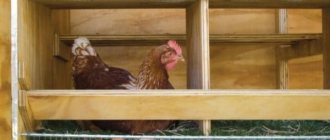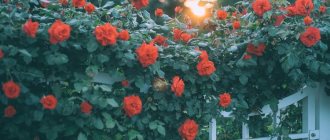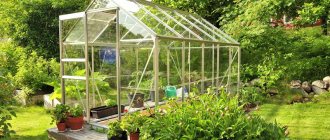Types of Rosaries
Flowerbeds with bright buds can contain several roses or consist of dozens of varieties. To find out how to design a rose garden in your country house, you need to consider the different types of plants suitable for flower beds.
You need to combine them correctly to achieve the desired result. There are several types of rose gardens used to decorate suburban areas.
Vertical rose garden
Weaving plants make amazing flower beds. They are used to decorate gazebos, arches and other structures in the garden. In order for the plants to develop in the right direction, supports are installed and shoots are tied up.
We recommend reading:
Do-it-yourself furniture from pallets - detailed instructions, as well as an overview of the best ideas for creating unusual and original furniture for the garden (120 photos)
Garden gnomes: TOP-150 photos of exclusive options for a summer cottage. Instructions on how to select and place decorative gnomes on your site
- Figurines for the garden: TOP-200 photos of the best ideas. Choosing a place, instructions on how to do it yourself, video. Only original options from the gardener!
Rose garden-rock garden
If you create a flower garden in the form of a rock garden, then they will require a minimum of care. Roses go perfectly with rocks.
Beautiful rose gardens are complemented by other green plants that act as a background for the buds.
Examples of combining roses with other plants
A corner has been decorated near the gazebo. Near the roses grow mantle and various conifers.
The rose grows surrounded by junipers, sage and other ground cover plants.
In this flower garden, roses coexist with pelargonium, barberry, peonies, and all this is beautifully mulched with wood chips, stones and small gravel.
For greater expressiveness, a broken clay pot is placed in the flower garden.
On a green lawn, roses look especially impressive, and a wall of conifers adds depth and contrast to a border of roses.
Selecting a location
For a rose garden, choose a sunny open area in the center of the garden or in front of the house. The flower garden in the recreation area of the site looks great. Roses prefer places that are well protected from gusts of wind.
The soil for the flower bed must be fertile. Clay soil holds water. It is not used for growing such flowers. If the place is suitable for planting plants, but the soil in this area is poor, then the top layer can be replaced.
We recommend reading:
A hedge on a property: TOP-best ideas on what to use to make a beautiful hedge on a plot. Photo, diagram, instructions, tips from the gardener
Do-it-yourself rock garden: step-by-step instructions on how to create a beautiful rock garden (145 photos and videos)
DIY stone flowerbed - 140 photos of stylish and beautiful ideas on how to build a stone flowerbed
Where to place the rose garden
Planting roses in landscape design should be on the sunny side or in the parterre lawn area. Since the latter is considered the most spectacular and elite lawn, it should not be hidden from prying eyes. The ground lawn is decorated with flower beds and ornamental shrubs.
The location should be well lit and protected from the wind. The best option for installing a rose garden is considered to be partial shade on the south side. For the normal development of flowers, they need sunlight and shade. If there is an excess of the former, then nothing good will be expected. Roses should be in the shade for at least 3 hours during the day, but at the same time they should receive sunlight for at least 6 hours.
Beauty. This is the first and most powerful argument. Whatever one may say, a rose is a flower of extraordinary beauty.
Flooded soils are a taboo for growing roses. It is recommended to plant the queen of flowers on land where there is well-drained loam. Acceptable soil acidity is 5.5-6.5 pH. On clay soils you will have to create a suitable microclimate. To do this, you need to add a little sand or peat mixture to the ground.
To arrange flowerbed arrangements you will need much more space than for a vertical rose garden. Here it is necessary to provide a small “border” of low-growing evergreen shrubs.
At the moment there are many fans of this culture. And the breeders took care of them, providing a large selection of different species.
Climbing roses grow best close to home. In this case, the plant may cling to the facade of the building. When it is not possible to plant them under the foundation of the house, roses are placed near the gazebos. A flower garden of climbing roses can be arranged anywhere on the site, but this will require portable arches or decorative partitions. Varieties with abundant flowering grow well near a pond. In this case, they act as a hedge.
Roses do not require special feeding or very complex care.
Important! When choosing a location for a rose garden, consider its scale. Plantings are selected according to shape and height. The rose garden is planted in separate or large groups. A polyanthus rose is planted in front, and a remontant, tea and park rose is planted in the background. Photos of landscape design with a rose garden will help you decide on the composition of roses on your site.
Drawing up a diagram
The chosen option for planting flowers depends on the taste preferences of the owners of the country house.
There are a large number of rose garden designs that will allow you to create a unique flower bed. To highlight this area, it is framed with pebbles or tiles are used for this purpose.
Choice of colors
Hybrid tea varieties captivate with their perfection. But they overwinter poorly and produce one shoot, crowned with a delicate flower.
There are abundantly flowering varieties. These include floribundas. They produce lush inflorescences and winter well. They do not bloom at the same time, so it is necessary to provide them with careful care.
Fallen petals should be removed daily to keep the flowerbed looking neat.
We recommend reading:
- Living fence at the dacha - 150 photos and videos of step-by-step instructions on how to create a tall and beautiful fence
The best flowers for the garden: 155 photos of simple and stylish solutions for creating flowers
Do-it-yourself landscaping - the best ideas for beautiful and functional site planning. Instructions, diagrams, photos, videos
Climbing large-flowered plants are distinguished by rigid shoots. To get a beautiful bush, pruning is required.
Scrub roses require a special approach. They grow short and require support. To get additional shoots, the branch must be directed horizontally.
Climbing varieties come in the following types: rambler, climber. They have long shoots and are suitable for arches. Rambler roses bloom once, but profusely. The lush inflorescences contain up to ten buds.
Plastic flexible shoots are easy to fix and lay according to the shape of the support used. The group of climbing roses is distinguished by large flowers and rigid branches.
A large number of varieties have been bred from hybrid tea species. Ground cover varieties are easy to cover for the winter. Plywood or boards should be placed under the shoots. They are great for retaining walls.
Adviсe
Keep in mind that you need to arrange flowers next to each other wisely. If you are still a beginner gardener, then it is better to read the relevant websites and literature - not all varieties look equally good side by side in the garden plot. Experienced flower growers advise beginners to plant luxury tea varieties and their hybrids nearby, and to grow ground cover specimens with miniature varieties. These combination options have already been tested and look great. They represent an almost sculptural composition with different drops and steps, making the composition with roses very picturesque. Climbing climbing varieties will look great both solo and in combination with other plants.
When decorating a rose garden or compositions, plant the flowers quite close to each other - this way the planting will look much more impressive. A dense flower bed is also more decorative than sparse plantings.
To vertically design a garden plot, it is necessary to use strong supports. Their design can be of any shape. Using supports, you can decorate the area near your dacha with unusual, sometimes even fantastic compositions, which will give it individuality. For example, a spiral support entwined with white and red chic flowers looks great. For vertical landscape design, a climbing rose is usually used. You should know that with the onset of cold weather you cannot remove the lashes from the support, but you need to cover the bushes along with the supports.
Additional plants
Roses look great without other plants. The empty space is often filled with lawn. Emerald grass highlights the delicate petals of flowers and makes the buds more expressive.
If you decide to decorate a rose garden at your dacha, adding other flowers to it, then you should make a plan in advance. Bulbous plants bloom early, when roses are just waking up after the cold. When daffodils and tulips fade, they are cut off.
Lilies begin to bloom later than these plants, but earlier than roses. They decorate the flowerbed. They are planted in the center so that the roses cover the gradually fading shoots of lilies.
Hosta is great for borders. Thanks to the wide foliage, the lower part of the shoots of roses, where there is no foliage and flowers, is hidden. To complement rose gardens, annuals of calmer tones are used so as not to obscure the dominant crop.
Roses in landscape design
Landscape design with roses will fit into any area that is flooded with sun for at least 6 hours a day. A rose garden is considered an independent composition that can become the basis of landscape design. It can be a flowerbed, vertical, in the form of an alpine hill or a large-scale flower garden, “cut” into several sections by paved paths. In addition to evergreen plants, shrubs and flowers, architectural forms and various buildings are used.
The layout most often includes:
- fountain;
- pool;
- a miniature copy of a natural reservoir;
- arches;
- sculptures;
- trellises;
- gazebos;
- pergolas;
- small architectural forms.
The interior design of the yard is the pride of the owner.
In order not to get lost among the roses in the garden design, they are interspersed with green spaces. You can use any variety for a rose garden, but you should not plant them all together. The dacha looks great with two or three varieties of roses. The combination of several types allows you to achieve the desired decorative effect. There is no need to demonstrate the entire range of varieties here. Your task is to create a colorful flower garden in the landscape.
An interestingly designed flower garden makes up 80% of a successful landscape design.
Preparing for landing
If a person is interested in how to make a rose garden, then it is worth taking the advice of more experienced gardeners.
Before planting plants, it is necessary to clear the area and prepare the soil. If the seedlings have bare roots, then the roses should be placed in warm water for a day.
You can store the material in a cold place for a week before planting in the soil. You just need to spray them with water every few days.
Landing
To plant a bush, dig a hole and loosen the soil in it. A shoot is installed and soil, previously mixed with compost and peat, is filled in. You should compact the soil a little and water the bush.
Afterwards the hole is completely filled with soil. Then you need to mulch the soil so that weeds do not grow near the rose. Watering is carried out several times a week.
Flowers and colors
When using roses in landscape design, they can be combined with other plants or inanimate objects (as in the examples above). To do this correctly and safely for the plant, pay attention to the following factors:
- plant compatibility (required amount of moisture, light, etc.);
- do artificial inclusions interfere with the normal growth of the flower;
- from an aesthetic point of view - color combinations.
These three factors are the main ones when arranging your garden and yard with roses. Be sure to monitor their implementation.
When selecting plants, consider compatibility
The color of the plants should be combined with other colors
Roses do not require special care
See alsoHow to use moldings in the interior
Care
Coniferous branches, straw, bark and other organic materials are used to mulch roses. They will begin to break down in the soil and will enrich it. Prune the bushes in early spring before the sap begins to flow.
During the same period, they are transplanted; this procedure can be carried out in the fall. The flowering time of roses depends on the plant variety. With the help of these amazing flowers you can create a certain atmosphere and mood in the garden.
Compositions with roses
No matter how long roses bloom, this period does not cover the entire warm season. Therefore, rosaries that include, in addition to roses, other flowers, are very successful. They serve as a background for the main crop and create a decorative effect before and after its flowering.
This composition is called a mixborder. For example, to make the flower garden look attractive in the spring, when the roses are just getting ready to release their first buds, perennials and spring bulbs are planted with them: poppies, irises, primroses, peonies, lupins, etc.
By the time the flowers appear on the rose, these plants will have bloomed, so you won't have to worry about compatibility.
After the roses, the flowerbed will be decorated with flowers with autumn decorativeness, planted here. The mixborder also includes plants that bloom at the same time as rose bushes. Here it is important to choose the right “environment” so that it serves only as a favorable background and does not distract the observer’s attention.
Plants that go well with roses:
- with inflorescences elongated upward (in harmony with rounded cup-shaped pink flowers): sage, delphinium, aconite, foxglove, bellflower, hydrangea;
- with a small bud and openwork inflorescences (emphasize the large size of roses): yarrow ptarmika, burnet, asparagus, basil, gypsophila paniculata;
- with elongated flowers: clematis, daylilies, curly, trumpet and Asiatic lilies.
The following are most often planted with ground cover roses in combined flower beds:
- in the lower tier - cuff, bells, irises;
- on average - delphinium, dahlias, foxgloves;
- in the accent - bulbous primroses, lilies, clematis.
Purple clematis (varieties Integrifolia and Viticella) fits perfectly into the rose garden. The composition will be significantly enriched by the beautiful foliage of small hostas, heuchera, wormwood, and cineraria.
The most successful complex flower beds are obtained with multi-flowered types of roses - ground cover, polyanthus, floribunda.
Photos of rose gardens at the dacha with your own hands
Did you like the article?
0
